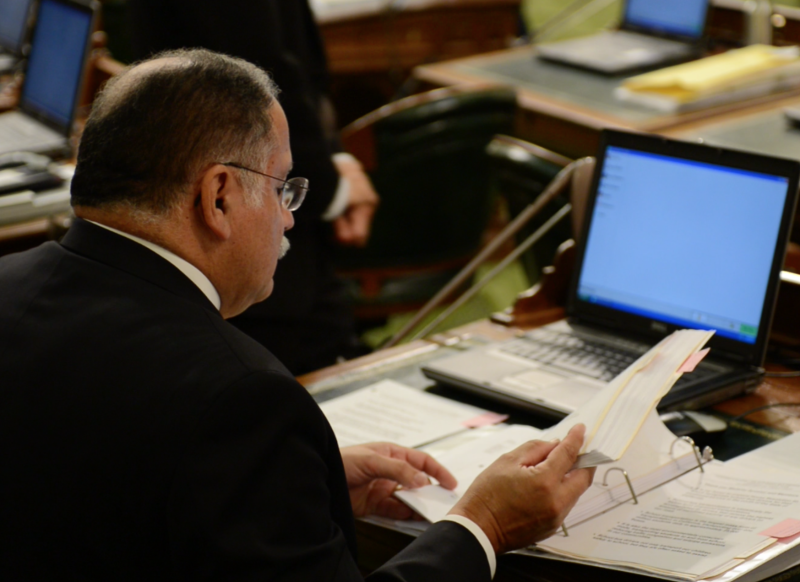Prop. 98 gives K-14 education the first call on tax revenues, while Prop. 2 sets aside money for a reserve fund and state debt. And in the budget pecking order, they come before just about everything.
Mandates Malleable, But They Shrink the Budget Battlefield
But here's the thing: Neither the overall tax revenue forecast nor the two mandate calculations are set in stone. Like so many things in the statehouse, they are molded by the hands of politicians.
"A lot of the numbers that go into Proposition 2 and Proposition 98 are, by their nature, subjective," says Jason Sisney, deputy analyst of the independent Legislative Analyst's Office (LAO). "The Legislature's charged with putting these numbers in the annual budget act, but under our system that's going to require negotiation with the governor."
And in recent years, it's the governor with the well-honed image of frugality who seems to be calling the shots.
"To avoid the mistakes of the past, we must spend with great prudence," said Gov. Jerry Brown in his 2014 State of the State speech. (He then handed out playing cards with a boom-and-bust chart on one side, and a photo of his dog, Sutter, on the other.)
The governor's cautious revenue projections have sparked some grumbling in the Legislature, but he's generally gotten his way. In each of the last three enacted budgets, general fund revenues were pegged to within $200 million of the number that was forecast by Brown prior to legislative negotiations.
Just as consistent, though, has been the failure of those forecasts to reflect the uptick in tax revenues, especially from high-income earners who account for the largest single share of the revenue pie.
That explains reaction to last week's LAO analysis that argues the governor's latest tax revenue projection is -- once again -- too low.
"We've certainly had this conversation every year for the past four years," state Sen. Mark Leno (D-San Francisco), the Senate's budget committee chairman, said in a recent hearing. "And," he said with a wide smile, "I won't review all the numbers that suggest whose estimates have been more accurate."
While the school funding guarantee has always been affected by the revenue projections (and this year is consuming most of the projected windfall), the newly enacted Prop. 2 adds an extra wrinkle, a requirement to stash away more money for bad times and then additional money for debt repayment.
Pick a tax revenue number, the size of the school guarantee, and the rainy day mandate ... and there's not much more left to discuss.
"When you do that, you may be left at the end with very little, or even nothing available for other commitments," says LAO's Sisney.
Which is why this year's debate is likely really going to come down to those three tasks.
Democrats Consider Boosting Child Care, Other Programs
The debate promises to be particularly interesting because even after setting aside the promised money to schools and the rainy day fund, LAO forecasters now believe there will be $1.1 billion in discretionary dollars beyond the revised forecast offered by Brown on May 14.
Democrats are pushing for as much as $600 million in additional spending (beyond the governor's plan) on child care and preschool programs. While Assembly Democrats would spend that money from the general fund, their colleagues in the Senate propose instead to count the child care assistance inside the Prop. 98 school funding system.
(And here's why the distinction is important: Boosting child care via Prop. 98 means one less demand on the budget's discretionary dollars, thus leaving more room for social service programs that legislative Democrats also want to boost.)
But all of this depends on how lawmakers and the governor privately agree to interpret the constitutional mandates for schools and reserves.
"The budget largely revolves around these two key formulas, Proposition 98 and Proposition 2," says Sisney of the Legislative Analyst's Office.
In a way, the two constitutional amendments leave less money to fight about; and that's a problem, say critics like journalist and author Joe Mathews, who last fall called Prop. 2 "a motley, impossible-to-understand array of restraints on the discretion of those foolish humans who dare try to govern and make state budgets in California."
Good or bad, the practical impact of Prop. 2's "no spend" and Prop. 98's "must spend" mandates may be a shift in the annual budget fight in Sacramento to predictions, not programs. Pick a revenue prediction and a way to interpret those voter-approved budget formulas, and the rest -- more general government spending, less general government spending -- may largely fall into place.
